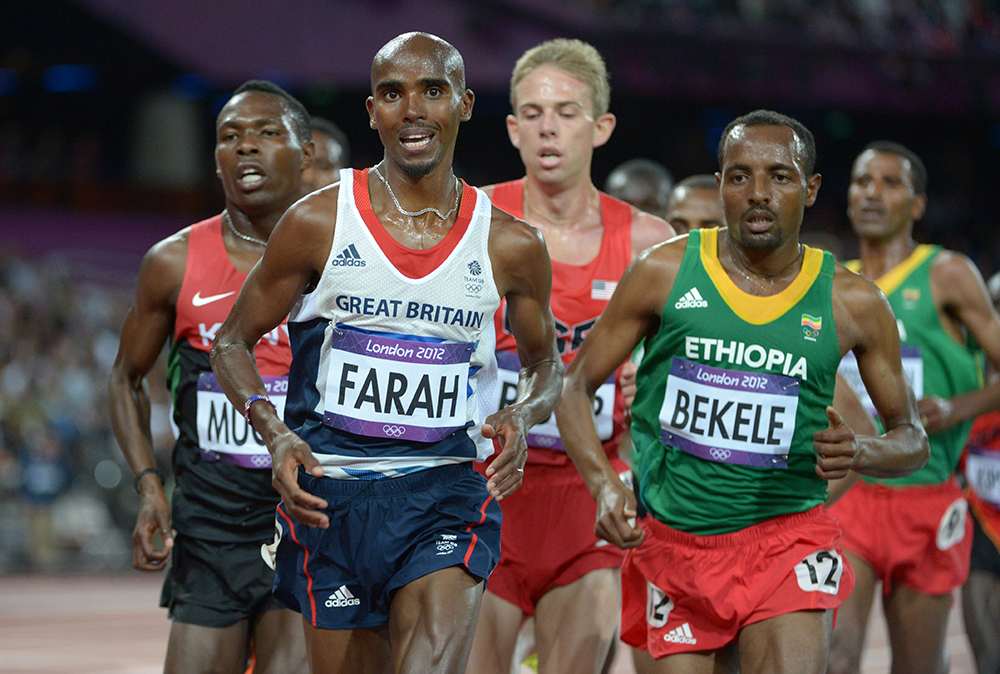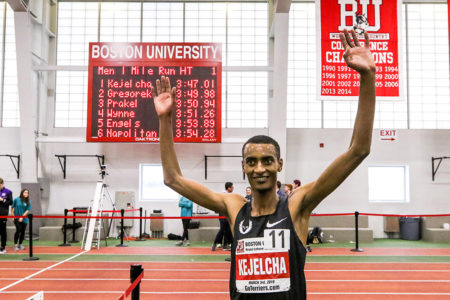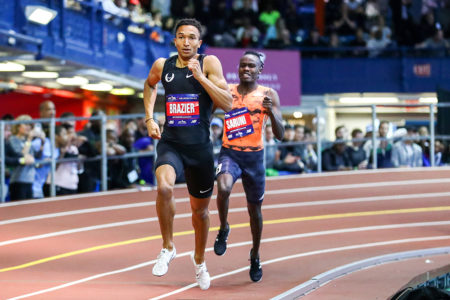Here’s this month’s collection of generally off-track activities that have gone a long way towards shaping the way the sport is headed

Mo Back On Track For Track?
When eleventeen-time gold medalist Mo Farah won the Diamond League 5K final in ’17, that was supposed to be the end of his track career. He quickly transitioned to the roads and showed great promise last year, winning the Chicago Marathon in 2:05:11. But after watching fellow Briton Laura Muir win a Euro Indoor double, he says he is considering a return to the track for the ’19 Worlds. “I do, I miss it, that sort of atmosphere Laura got,” he said. “I do miss representing my country. Part of me, when I watch track races, I’m like: ‘Can I still do it? I want to do it.’”
Farah, who will turn 36 on March 23, still considers the 10K a viable option, explaining, “Seeing the results it hasn’t really changed. The athletes doing well are in 1500m indoors, the mile, the young Norwegian kid, but in terms of long distances it hasn’t really changed much and that’s part of me thinking: ‘Have I still got it?’” He says that no decision will be made until after he runs April’s London Marathon.
Next Year’s NCAA/OT Logjam
Collegians who compete in the ’20 NCAA Championships will find themselves operating on short rest if they’re planning on participating in the Olympic Trials as well. Since the men’s and women’s OT merged for the ’76 edition, there has never been a gap as tight as what’s in store for next June. Correspondent Howard Willman crunched the numbers, and here’s how things have shaken out since the historic ’76 affair, with number of days from the last day of the NCAA to the first day of the Trials (there was no NCAA for women in ’76 or ’80):
1976 — 14 days (June 05–June 19) (women’s gap from the AIAW 35 days)
1980 — 14 days (June 07–June 21) (women’s gap 28 days)
1984 — 14 days (June 02–June 26)
1988 — 51 days (June 04–July 15)
1992 — 13 days (June 06-June 19)
1996 — 13 days (June 01-June 14)
2000 — 51 days (June 03–July 14)
2004 — 27 days (June 12–July 09)
2008 — 13 days (June 14–June 27)
2012 — 13 days (June 09–June 22)
2016 — 20 days (June 08–July 01)
2020 — 06 days (June 13–June 19)
Africans Unhappy With DL Distance Changes
The IAAF’s plan to cut 8 events from the DL in ’20 (see sidebar) so far has specified only the men’s and women’s 5000s as getting the chop. Ethiopian and Kenyan officials quickly announced plans to register displeasure. The 5000’s DL demise (many reports erroneously imply the 10,000 has until now been a DL event) is not going over well with distance athletes and fans anywhere. But East Africa, where distance is the lion of the realm, is most unhappy, perceiving a knock at tradition and athletes’ earning power.
Two East African legends weighed in. Haile Gebrselassie told Reuters, “It is a sad decision that will disproportionately affect Ethiopia and Kenya, as well as East Africa as a whole. …At a time when the body needed to exert its maximum effort to boost athletics worldwide, it has taken a decision that is tragic and unfair.”
Marathon WR holder Eliud Kipchoge, whose big-time career started with ’03 WC 5000 gold, called the track race “crucial for my career and [the event] has helped me to become the athlete I am today. I hope future athletes will have the possibility to follow this exact same path in their careers.”
Ever Tried To Check A Chunk Of 16-Foot Luggage?
Ah, to live the glorious life of a professional pole vaulter… or sometimes maybe not so much, as Sandi Morris recently took to Twitter to lament, explaining one of the great downsides of her event. “I don’t think many understand just how difficult it is to be a traveling pole vaulter,” she said. “We are limited not only to specific airlines, but also specific air CRAFT. My travel costs typically twice that of someone traveling with regular sized luggage & the trips are much longer.”
She continued, “Thinking of this now as I sit on the phone with my manager (for over an hour) trying to find a decent route to get to Shanghai. Also, meets don’t provide vaulters more travel $$, making it even more difficult to find a route within budget.”
Russia Says No More Beer For Sample Production
Most pros have had this problem: you’re selected for dope testing after your competition, but you’re dehydrated following the physical exertion and have trouble producing a sample. The obvious answer is perhaps a brewski or two, but Russia says those days are gone, with RUSADA official Margarita Pakhnotskaya telling the Associated Press that the only option is “large quantities of water.”
Pakhnotskaya elaborated that drinking was a particular problem with track & field athletes, noting, “It is not very good for athletes’ behavior at doping control, politeness and following the rules. They’d be rude, a bit aggressive.” She also said beer could interfere with the results of the biological passport program: “Beer influenced it a lot. It could cause or hide some changes.” She did say there was no evidence athletes were using beer to try to manipulate tests.
This story reminds us of the Wild Wild West early days of testing, when protocols were nowhere near as stringent as they are today. A Canadian Olympian once regaled us with the tale of being selected with another athlete from his event for post-competition testing and when they said they couldn’t produce a sample, they put them in a room with a refrigerator and said “drink some beer.” To their delight on a warm day, the two found a whole case of beer and proceeded to polish off the whole thing, telling the testers every time they came to the door, “No, not yet!”
van Niekerk Remains Optimistic About World Champs
His first race in more than a year was an altitude-aided 47.28 in late February, but 400 WR holder Wayde van Niekerk has told Agence France-Presse that he’ll “probably” be running in Doha in September, although he was noncommittal on when he might next race. Before his modest rust-buster in Bloemfontein, the last time van Niekerk had competed was at the ’17 WC. In the fall of that year he injured a knee playing touch rugby and ended up missing all of the ’18 campaign.
Saying he was “working way too hard to not be there,” the 26-year-old South African continued, “I think I’ll be there and I think things are going my way. It’s going quite good. My team is very patient with me. I honestly believe I will be there and I will be able to compete quite well. I’m excited to get back into the mix. I had a lot of time to sit back and understand the situation I’m going through. I come back stronger… mentally I feel very strong, physically I still need to do work.”
A Brand New Look For The Walks?
With a single vote, the IAAF has completely revamped the walks, and not all hell-and-toe practitioners are pleased. On March 11 the proposals made by the Racewalking Committee were agreed to “in principle” at an IAAF Council meeting in Doha.
The biggest casualty is apparently the 50K walk, which is no longer on the slate of events. IAAF head Seb Coe said that for future walking majors after ’20, two walking distances would be chosen from these four: 10K, 20K, 30K or 25K. According to Coe, this is part of a push to make the sport more TV-friendly and accessible to younger fans. “We had a spirited and detailed debate and discussion on racewalking,” said Coe. (Aside: there have been suggestions on our message board that if new events are needed, they should be the half-marathon and marathon, so they’d mean more to the general public.)
Coe continued, “The Council specifically agreed with the importance of, firstly, maintaining a 4-medal discipline with 2 men’s and 2 women’s events at all major international competitions. Second, continuing to prioritize investment in and development of the racewalking control system, i.e. the racewalking chip and its sole technology. Thirdly testing and validating technology in competition during and beyond 2020 if necessary.”
Maurizio Damilano, the ’80 Olympic gold medalist in the 20K, is head of the Walk Committee. He added, “Our main goal right now is to secure the future of racewalking beyond Tokyo 2020… Changes are not always an easy thing, but it is absolutely necessary to make racewalking more appealing for fans and for young athletes.”
Some World-Class Walkers Push Back
In reaction to the IAAF’s game-changing plans for walking, an opposition group named “Save The Racewalking” has been formed, counting among its members a host of world-class athletes.
The group has charged the Walk Committee with misrepresenting the results of its own poll that was sent out to member federations, concluding in a statement, “It is clear that the IAAF RWC has very confused ideas, not worked transparently and is not acting for the interests of racewalking.”
Many walkers have expressed concern about the in-shoe chip technology that is coming, officially called the Racewalking Electronic Control System (RWECS).
Among the questions raised: Will it be so sensitive that it slows walkers down significantly? Can the system be hacked? Will athletes still be judged for bent knees? Will it be widely available for training purposes so walkers can adapt to competition conditions? Will the cost of implementing the system be an undue burden on regional walk organizers?
The Save The Racewalking group is urging that the IAAF delays any implementation of new distances till after the ’24 Games, while using that timeframe to test the RWECS technology. □






